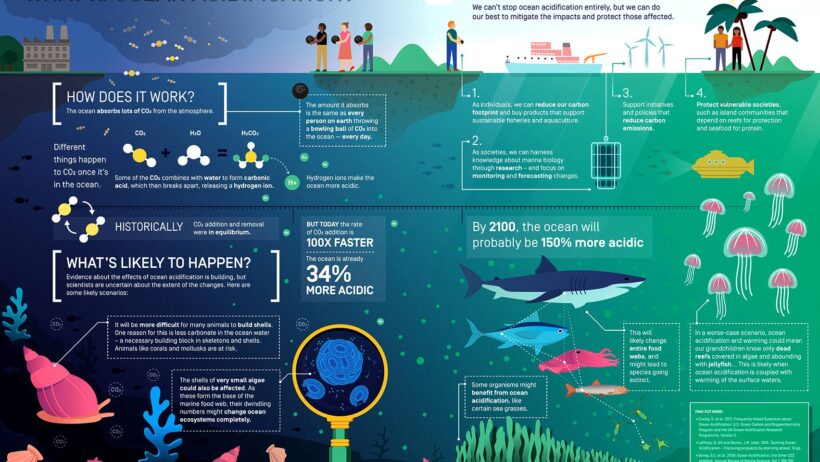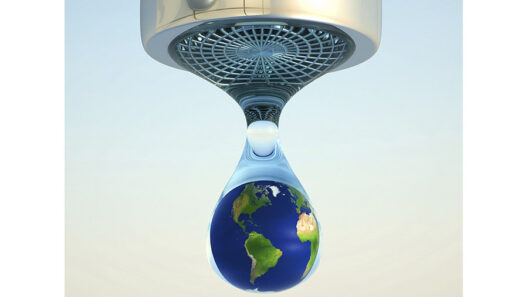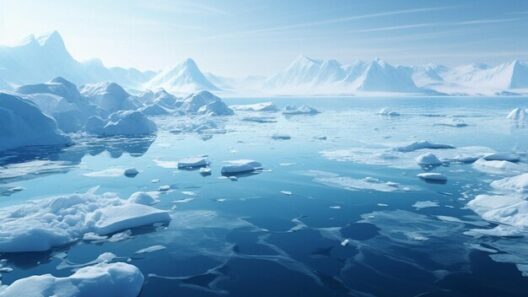The future of our oceans is fraught with peril, yet it also presents an opportunity for profound transformation in our relationship with the environment. As we examine the dual threats of acidification and warming, we must confront the stark reality that these phenomena are inexorably linked to human activity. The time to act is not tomorrow, but today.
Ocean acidification is a direct consequence of increased atmospheric carbon dioxide (CO2) levels. When CO2 is absorbed by the ocean, it reacts with seawater to form carbonic acid, thereby lowering the pH of the water. This process can have dire implications for marine life, particularly for organisms with calcium carbonate structures, such as corals, mollusks, and certain plankton. These organisms are foundational to marine ecosystems and provide vital services, including supporting food webs and acting as natural carbon sinks.
Meanwhile, global warming, driven primarily by greenhouse gas emissions, exacerbates oceanic challenges. Rising temperatures result in warmer water, which can lead to coral bleaching, reduced oxygen levels, and altered species distributions. The interplay between warming and acidification creates a precarious situation for already stressed marine ecosystems. Ecosystem collapse is not just an environmental concern; it threatens livelihoods, food security, and global economies.
Yet, amidst this dire prognosis, there lies promise. An increased awareness of the precarious state of our oceans has invigorated conversations about sustainable practices and policies. Innovations in marine conservation and restoration techniques offer hope. For instance, the concept of “blue carbon,” which refers to the carbon stored in coastal ecosystems like mangroves, salt marshes, and seagrasses, has gained traction. Protecting and restoring these vital habitats can mitigate climate change while promoting biodiversity.
Furthermore, there is an ongoing movement to establish marine protected areas (MPAs). By regulating fishing, tourism, and other activities, MPAs can foster biodiversity and resilience in marine ecosystems. Research shows that healthy, diverse ecosystems are better able to withstand the stresses related to climate change. Expanding MPAs can be pivotal in allowing marine life the space to adapt and thrive.
Education plays a crucial role in this struggle. Engaging with communities and raising awareness about the importance of ocean health can inspire grassroots activism. Schools, NGOs, and local governments can harness the power of education to cultivate a generation that is informed and motivated to protect our oceans. Volunteer opportunities in coastal clean-ups, coral restoration projects, and citizen science initiatives can mobilize individuals and communities to take action.
Technological advancements are also forging new pathways for ocean conservation. Satellite technology enables scientists to monitor ocean temperatures, acidity levels, and biodiversity from afar. Data collected can inform policy decisions and conservation strategies. Meanwhile, innovations in sustainable fishing practices and aquaculture can minimize the impact on marine ecosystems. Selective breeding of fish species can help develop more resilient populations, while integrated multi-trophic aquaculture harnesses the benefits of symbiotic species to create a more sustainable food production model.
Policy plays a pivotal role in safeguarding ocean health. International collaboration is essential, as oceans do not adhere to geopolitical boundaries. Treaties such as the United Nations Framework Convention on Climate Change (UNFCCC) and the Paris Agreement emphasize the global commitment to addressing climate change impacts. Achieving consensus on marine issues can be challenging, but recent initiatives to combat illegal fishing and protect biodiversity highlight the importance of a cooperative approach. Such collaborative efforts must be bolstered by scientific research and data to develop effective management strategies and policies.
Despite the overwhelming odds, individuals can make a difference through their choices. Supporting sustainable seafood, reducing plastic consumption, and advocating for policies that address climate change can empower consumers to have a direct impact on ocean health. The ripple effect of informed consumerism can drive industries to adopt more sustainable practices, creating a market demand for ocean-friendly products.
In a world where visual representation matters, the power of infographics and art can be mobilized to communicate the urgency of ocean conservation. Visually striking representations of the dangers posed by pollution, acidification, and warming can evoke emotional responses and educate the public about the multifaceted challenges facing marine environments. By fostering a connection between the audience and the ocean, such media can spur action and promote advocacy.
The future of our oceans hinges on a collective effort to change our narrative. We must shift from a mindset of exploitation to one of stewardship. This evolution requires interdisciplinary collaboration, leveraging the expertise of scientists, policymakers, activists, and the public alike. Each stakeholder plays a vital role in the fight against climate change and the preservation of our oceans.
In conclusion, the battle against ocean acidification and warming is not solely about mitigating negative impacts; it is an opportunity to redefine our interactions with nature. As we transition to a more sustainable paradigm, we must cultivate resilience in our oceans, ensuring that they continue to provide for future generations. The story of our oceans is not merely one of decline; it can be a beacon of hope, illustrating the profound effects of collective action and conscious decision-making.
As stewards of this planet, we possess the agency to drive change. Now is the time to nurture this promise and commit to safeguarding our oceans for the generations yet to come. The tide is turning; may we choose to steer it in the right direction.








